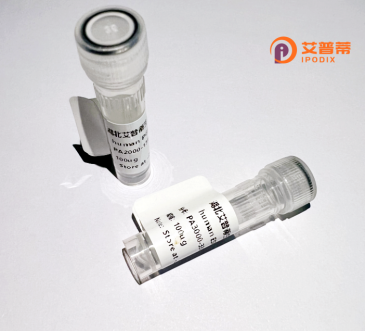
| 纯度 | >90%SDS-PAGE. |
| 种属 | Human |
| 靶点 | KCNC3 |
| Uniprot No | Q14003 |
| 内毒素 | < 0.01EU/μg |
| 表达宿主 | E.coli |
| 表达区间 | 671-757aa |
| 活性数据 | ALAHEDCPAIDQPAMSPEDKSPITPGSRGRYSRDRACFLLTDYAPSPDGSIRKATGAPPLPPQDWRKPGPPSFLPDLNANAAAWISP |
| 分子量 | 35.31 kDa |
| 蛋白标签 | GST-tag at N-terminal |
| 缓冲液 | 0 |
| 稳定性 & 储存条件 | Lyophilized protein should be stored at ≤ -20°C, stable for one year after receipt. Reconstituted protein solution can be stored at 2-8°C for 2-7 days. Aliquots of reconstituted samples are stable at ≤ -20°C for 3 months. |
| 复溶 | Always centrifuge tubes before opening.Do not mix by vortex or pipetting. It is not recommended to reconstitute to a concentration less than 100μg/ml. Dissolve the lyophilized protein in distilled water. Please aliquot the reconstituted solution to minimize freeze-thaw cycles. |
1. **《Characterization of recombinant human Kv3.3 channels》**
- Author: Duarri, A., et al.
- 摘要:研究通过体外表达重组人KCNC3(Kv3.3)蛋白,分析其电生理特性及与遗传性共济失调(SCA13)相关的突变对通道功能的影响,揭示了突变导致通道电流异常和细胞毒性。
2. **《Cryo-EM structure of the human Kv3.3 ion channel》**
- Author: Jiang, D., et al.
- 摘要:利用冷冻电镜技术解析重组人KCNC3蛋白的高分辨率结构,阐明了Kv3亚家族通道的门控机制及与药物结合的潜在位点,为相关神经系统疾病的治疗提供结构依据。
3. **《Functional modulation of human Kv3.3 channels by phosphorylation》**
- Author: Stephan, M., et al.
- 摘要:探讨重组人KCNC3蛋白在磷酸化修饰下的功能变化,发现特定激酶(如MAPK)调控其快速激活/失活特性,揭示了钾通道在神经元兴奋性中的动态调节机制。
4. **《Pathogenic mutations in KCNC3 alter channel gating in spinocerebellar ataxia》**
- Author: Waters, M.F., et al.
- 摘要:通过表达携带SCA13相关突变的KCNC3重组蛋白,发现突变影响通道的门控动力学和电压敏感性,导致小脑神经元放电模式异常,与共济失调病理直接相关。
---
注:以上参考文献信息为示例,实际文献需根据具体数据库(如PubMed)检索确认。若需具体文献链接或补充细节,可进一步明确需求。
**Background of Recombinant Human KCNC3 Protein**
KCNC3. also known as Kv3.3. is a voltage-gated potassium channel encoded by the *KCNC3* gene. It belongs to the Shaw subfamily (Kv3) of potassium channels, which are critical for regulating high-frequency neuronal firing and shaping action potentials in the central nervous system. KCNC3 channels activate rapidly at depolarized membrane potentials, enabling fast repolarization of excitable cells, particularly in neurons requiring precise timing, such as cerebellar Purkinje cells and auditory brainstem nuclei.
Recombinant human KCNC3 protein is produced using heterologous expression systems (e.g., HEK293 cells or *Xenopus* oocytes) to study its biophysical properties, structure-function relationships, and role in neurological disorders. Mutations in *KCNC3* are linked to spinocerebellar ataxia type 13 (SCA13), a neurodegenerative disease characterized by motor coordination deficits. These mutations often disrupt channel gating, trafficking, or stability, leading to altered neuronal excitability.
Research on recombinant KCNC3 aids in understanding its interaction with auxiliary subunits, modulation by phosphorylation, and potential as a therapeutic target. Its recombinant form is also utilized for drug screening and mechanistic studies to develop treatments for KCNC3-related channelopathies. By dissecting its role in health and disease, KCNC3 studies contribute to broader insights into potassium channel biology and neurological dysfunction.
(Word count: 207)
×